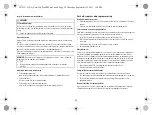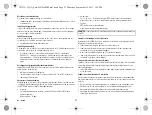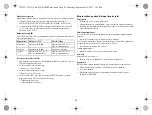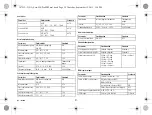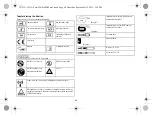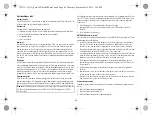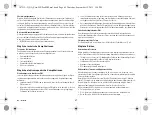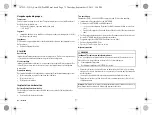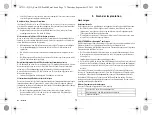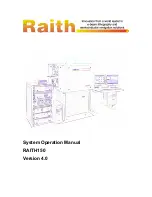
de • Deutsch
65
de • Deutsch
Inhaltsverzeichnis
Produktbeschreibung . . . . . . . . . . . . . . . . . . . . . . . . . . . . . . . . . . . . . . . . . . . . . . . . . . . . 65
Medizinische Zweckbestimmung. . . . . . . . . . . . . . . . . . . . . . . . . . . . . . . . . . . . . 65
Systemübersicht . . . . . . . . . . . . . . . . . . . . . . . . . . . . . . . . . . . . . . . . . . . . . . . . . . 66
Implantatvarianten und NBG-Codes . . . . . . . . . . . . . . . . . . . . . . . . . . . . . . . . . . 67
Diagnostik- und Therapiefunktionen. . . . . . . . . . . . . . . . . . . . . . . . . . . . . . . . . . 67
Lieferumfang. . . . . . . . . . . . . . . . . . . . . . . . . . . . . . . . . . . . . . . . . . . . . . . . . . . . . 68
Allgemeine Sicherheitshinweise. . . . . . . . . . . . . . . . . . . . . . . . . . . . . . . . . . . . . . . . . . . 68
Mögliche medizinische Komplikationen . . . . . . . . . . . . . . . . . . . . . . . . . . . . . . . 68
Mögliche technische Komplikationen . . . . . . . . . . . . . . . . . . . . . . . . . . . . . . . . . 69
Mögliche elektromagnetische Komplikationen . . . . . . . . . . . . . . . . . . . . . . . . . 69
Mögliche Risiken. . . . . . . . . . . . . . . . . . . . . . . . . . . . . . . . . . . . . . . . . . . . . . . . . . 69
Vor der Implantation. . . . . . . . . . . . . . . . . . . . . . . . . . . . . . . . . . . . . . . . . . . . . . . . . . . . . 70
Indikationen und Kontraindikationen . . . . . . . . . . . . . . . . . . . . . . . . . . . . . . . . . 70
Umgebungsbedingungen . . . . . . . . . . . . . . . . . . . . . . . . . . . . . . . . . . . . . . . . . . . 71
Sterilität. . . . . . . . . . . . . . . . . . . . . . . . . . . . . . . . . . . . . . . . . . . . . . . . . . . . . . . . . 71
Implantation vorbereiten . . . . . . . . . . . . . . . . . . . . . . . . . . . . . . . . . . . . . . . . . . . 71
Implantation. . . . . . . . . . . . . . . . . . . . . . . . . . . . . . . . . . . . . . . . . . . . . . . . . . . . . . . . . . . . 72
Implantieren . . . . . . . . . . . . . . . . . . . . . . . . . . . . . . . . . . . . . . . . . . . . . . . . . . . . . 72
HSM-Elektroden anschließen . . . . . . . . . . . . . . . . . . . . . . . . . . . . . . . . . . . . . . . 72
Vorsichtsmaßnahmen beim Programmieren . . . . . . . . . . . . . . . . . . . . . . . . . . . 73
Nach der Implantation . . . . . . . . . . . . . . . . . . . . . . . . . . . . . . . . . . . . . . . . . . . . . . . . . . . 75
Nachsorgen . . . . . . . . . . . . . . . . . . . . . . . . . . . . . . . . . . . . . . . . . . . . . . . . . . . . . . 75
Hinweise für den Arzt . . . . . . . . . . . . . . . . . . . . . . . . . . . . . . . . . . . . . . . . . . . . . . 76
Austauschindikationen . . . . . . . . . . . . . . . . . . . . . . . . . . . . . . . . . . . . . . . . . . . . . 76
Explantation und Implantatwechsel . . . . . . . . . . . . . . . . . . . . . . . . . . . . . . . . . . 77
Parameter . . . . . . . . . . . . . . . . . . . . . . . . . . . . . . . . . . . . . . . . . . . . . . . . . . . . . . . . . . . . . 78
Modi . . . . . . . . . . . . . . . . . . . . . . . . . . . . . . . . . . . . . . . . . . . . . . . . . . . . . . . . . . . . 78
Zeitsteuerung: 3-Kammer . . . . . . . . . . . . . . . . . . . . . . . . . . . . . . . . . . . . . . . . . . 78
Stimulation und Wahrnehmung: 3-Kammer . . . . . . . . . . . . . . . . . . . . . . . . . . . 79
Frequenzadaption . . . . . . . . . . . . . . . . . . . . . . . . . . . . . . . . . . . . . . . . . . . . . . . . 81
Voreingestellte Programme: 3-Kammer . . . . . . . . . . . . . . . . . . . . . . . . . . . . . . 81
Toleranzen der Parameterwerte . . . . . . . . . . . . . . . . . . . . . . . . . . . . . . . . . . . . . 82
Technische Daten . . . . . . . . . . . . . . . . . . . . . . . . . . . . . . . . . . . . . . . . . . . . . . . . . . . . . . . .83
Mechanische Kenndaten . . . . . . . . . . . . . . . . . . . . . . . . . . . . . . . . . . . . . . . . . . . 83
Elektrische Kenndaten . . . . . . . . . . . . . . . . . . . . . . . . . . . . . . . . . . . . . . . . . . . . . 83
Batteriedaten. . . . . . . . . . . . . . . . . . . . . . . . . . . . . . . . . . . . . . . . . . . . . . . . . . . . . 84
Legende zum Etikett . . . . . . . . . . . . . . . . . . . . . . . . . . . . . . . . . . . . . . . . . . . . . . . 85
1 Produktbeschreibung
Medizinische Zweckbestimmung
Bestimmungsgemäße Anwendung
Evia ist der Name einer Familie von implantierbaren Herzschrittmachern, die bei allen
Indikationen von bradykarden Herzrhythmusstörungen implantiert werden können.
Primäres Ziel der Therapie ist die Verbesserung klinisch manifestierbarer Symptome
der Patienten. Die Implantation des Schrittmachers ist eine symptomatische Therapie
mit folgendem Ziel:
• Kompensation von Bradykardien durch atriale, ventrikuläre oder AV-sequenzielle
Stimulation
• Resynchronisation der ventrikulären Kammerkontraktion durch biventrikuläre
Stimulation
Diagnose- und Therapieformen
Der Herzrhythmus wird automatisch überwacht und bradykarde Rhythmusstörungen
werden behandelt. Alle wesentlichen Therapieansätze aus Kardiologie und Elektro-
physiologie sind in der Evia-Familie vereint. BIOTRONIK Home Monitoring
®
ermöglicht
Ärzten ein Therapiemanagement rund um die Uhr.
Vorausgesetzte Fachkenntnisse
Außer den medizinischen Grundlagen sind detaillierte Kenntnisse über die Funktions-
weise und die Einsatzbedingungen eines Implantatsystems erforderlich.
• Nur medizinische Fachkräfte mit diesen besonderen Kenntnissen können Implan-
tate bestimmungsgemäß anwenden.
• Wenn diese Kenntnisse nicht vorhanden sind, müssen die Anwender geschult
werden.
387513--D_GA_Evia-HF-ProMRI_mul.book Page 65 Thursday, September 12, 2013 3:34 PM


